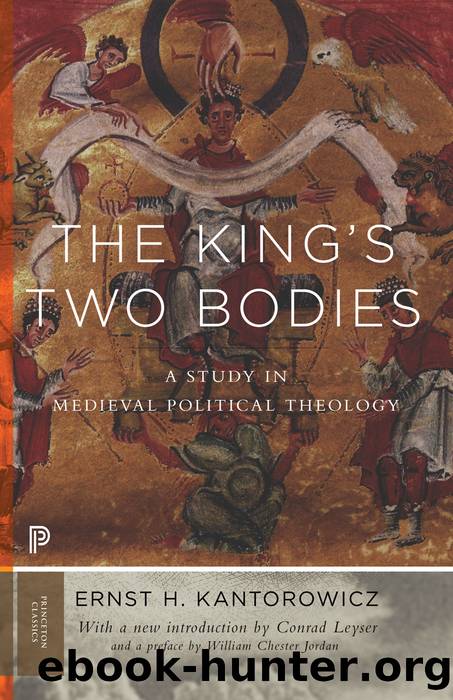The King's Two Bodies by unknow

Author:unknow
Language: eng
Format: epub
ISBN: 9780691169231
Publisher: PrincetonUP
Published: 2016-07-15T05:00:00+00:00
CHAPTER VI
ON CONTINUITY AND CORPORATIONS
1. Continuity
UNDOUBTEDLY the concept of the âkingâs two bodiesâ camouflaged a problem of continuity. This was less evident, or perhaps only more concealed, in the earlier Middle Ages. But the truly essential point became manifest as well as articulate when, as a result of the reception of the Aristotelian doctrine of the âeternity of the worldâ and its more radical Averroist interpretation, the question of perpetual continuity itself became a philosophic problem of the first order.
The revival of the doctrine of the eternity of the world, which captivated Western minds after the middle of the thirteenth century,1 coincided with analogous, if independent, tendencies towards âcontinuityâ in the constitutional and legal-political spheres. For it would be a mistake to assume that the new philosophic tenet produced, caused, or created a new belief in the perpetual continuity of political bodies. Facts of chronology would preclude such a hypothesis anyhow, because the development towards continuity in the fields of law and politics was already in full swing before an influence of the new philosophy could have been effective. Practice, as usual, preceded theory; but existing practice made the minds all the more receptive for a new theory. However, simultaneity does not imply causality, and all that can be said is that the philosophy defending the infinite continuum of Time made its appearance as a concomitant of related trends in other fields; further, that the ground was peculiarly well prepared to receive a doctrine which confirmed and justified what one thought or did anyhow, and thereby intensified and accelerated existing conditions; finally, that both strandsâthe philosophic-scholastic theory and the politico-legal practiceâtogether decisively influenced the general pattern of Western social and political thought in its formative period.
For all those restrictions it would be nevertheless inexcusable to ignore the impact of the new trends in philosophy, because such neglect would whittle down our capability of understanding more profoundly the corresponding phenomena in other sectors of thoughtâconstitutional, legal, or political. The heated arguments between philosophers and theologians about meaning and effects of an infinite continuity contributed, to say the least, to the articulation of some phenomena which previously had been difficult to express, or had not been expressed at all because they had not penetrated the conscious mind. Now, in the wake of the Aristotelian revival, the Averroist extremists, the moderate Aristotelians, and the anti-Aristotelians had each to produce their reasons for and against an eternity of the world. The very fact that the definition of continuity, duration, perpetuity, sempiternity, eternity, and related notions formed, over and over again, a matter for discussion and argument seems telling enough: it reveals to the historian that something formerly stable and settled had become unstable and unsettledâor even questionableâand that some serious change was taking place within the realm of Time, and in manâs relation to Time.
Whereas the philosophic aspects of that change have been studied frequently and are known well enough, the historical inferences of that new attitude toward Time, difficult to substantiate as they are, have hardly been investigated.
Download
This site does not store any files on its server. We only index and link to content provided by other sites. Please contact the content providers to delete copyright contents if any and email us, we'll remove relevant links or contents immediately.
The Fine Print (Dreamland Billionaires Book 1) by Lauren Asher(2403)
Fury of Magnus by Graham McNeill(2364)
The Last House on Needless Street by Catriona Ward(2189)
The Rose Code by Kate Quinn(2087)
Malibu Rising by Taylor Jenkins Reid(1813)
Luster by Raven Leilani(1803)
Transcendent Kingdom by Yaa Gyasi(1772)
A Little Life: A Novel by Hanya Yanagihara(1766)
Moonflower Murders by Anthony Horowitz(1732)
The God of the Woods by Liz Moore(1579)
The Lost Book of the White (The Eldest Curses) by Cassandra Clare & Wesley Chu(1523)
This Changes Everything by Unknown(1425)
The Midwife Murders by James Patterson & Richard Dilallo(1381)
The Lying Life of Adults by Elena Ferrante(1353)
The New Wilderness by Diane Cook(1339)
Written in the Stars by Alexandria Bellefleur(1322)
Wandering in Strange Lands by Morgan Jerkins(1287)
Ambition and Desire: The Dangerous Life of Josephine Bonaparte by Kate Williams(1284)
The Lying Life of Adults by Elena Ferrante;(1237)
